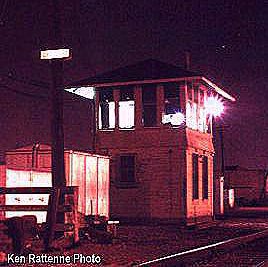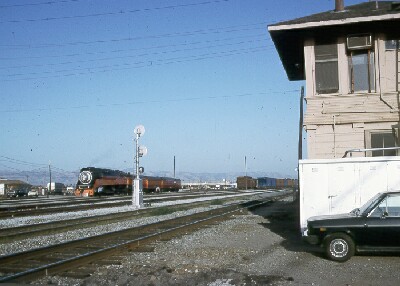
Santa Clara Tower . . |
"Little
Tower"
Santa Clara Tower basks in the warm glow of mercury vapor lighting in July of 1993. The operator is still busy making his log entry after an Oakland-bound freight passed under his watchful eye.
|
"2472 -- (This is) Santa Clara"
"2472, here"
"Extra 2472, you have permission to go against the stop indication from the eastbound to the freight main."
- Tower Operator "Margaret"
July 23, 1992. Former SP
Pacific 2472 is returning from San Francisco with an National Railway Historical
Society excursion, a long train of Daylight-painted passenger cars on its
drawbar. Dusk is quickly turning to night as the stately 4-6-2 does a slow
march past Santa Clara Tower and a quietly steaming 4449, its mars light
swinging wildly six tracks over. As the small crowd of onlookers stands
gawking at the sight and sound of these two veteran steamers whistling
off at each other, the Santa Clara Tower OS is busy getting ready for her
next train movement.
 |
Santa Clara Tower Margaret (mp3) |
 |
SP 2472 - 4449 Whistles off (mp3) |
Santa Clara Tower is literally half the size of its College Park brother, adhering more closely to the lines of a classic interlocking tower. Situated 1.4 railroad miles west (geographical north) from College Park, Santa Clara Tower sits next door to the historic Santa Clara CalTrain depot, restored by the City Of Santa Clara and the model railroad club housed within the east wing of the building.
Though the tower's design is similar to other SP structures (it once had a twin at Radum, in the town of Pleasanton), Santa Clara Tower does not bear much resemblance to its big brother at the other end of Newhall Street Yard. For instance, SC Tower is square, College Park oblong; College Park is painted yellow, SC Tower is painted a uniformly dull tan over its entire surface.
Climbing the rickety steps to the tower's second story,
operators had a view overlooking the west leads of San Jose Yard. Just
to the tower's north is the junction with the Oakland-San Jose Mulford
Line, used by Amtrak's Coast Starlights, Capitols, and most mainline freights.
This busy line forms a junction with Southern Pacific's Coast Line to Los
Angeles, connecting to the double-track mainline now owned by the JPB.
Santa Clara operators coordinated the access to this line, plus controlled
movements operating in and out of the once-busy San Jose Yard.
|
Operator Don Douglas (who by no coincidence is also the editor of the Ferroequinologist, the monthly newsletter for the Central Coast Chapter, NRHS) is a Bay Area tower historian. Don says the current tower is thought to be the second such structure, probably built in 1926 or 1927 when the new San Jose yard was built. The original Santa Clara Tower was built as an Armstrong plant in either 1902 or 1903 to control the crossing of the South Pacific Coast narrow gauge railroad of the commute line just south of the present day tower. Douglas has worked all three tower positions in San Jose (as has his wife). In the end, Don worked first trick at Santa Clara right through to its closing in July of 1993. He remembers what it was like right after Amtrak took over operations:
"When Amtrak came in they assigned all these former Conrail men to supervise the transition, and these guys had their own slang. We call our switchers switch engines or yard goats, Amtrak immediately began calling them 'shifters'. Then all of a sudden Amtrak began referring to 'pin-up crews', meaning our hostlers. We all scratched our heads on that one".
Another change was the designation of control points. While commonplace on other railroads, Southern Pacific never embraced idea. Thus, the new "CP's" were yet another "foreign concept" for towerman and train crews.
Santa Clara Tower marks the beginning of CP Coast, which extends to College Park Tower; then it's CP Stockton (for the Stockton Avenue grade crossing) to the Julian Street underpass, where CP Julian begins. CP Julian then extends its influence all the way to the Cahill Street depot (now called Diridon Depot for one of San Jose's city officials). (See map for detail)
With the assumption of CalTrain's operating contract by
Amtrak, the Tower Consolidation Project was pushed to completion within
a year of Amtrak's takeover. During Don Douglas's final shift at Santa
Clara on July 16, 1993, the SP signal department cut the circuits to the
interlocking plant, forcing control of switches and signals to be performed
manually by signal maintainers at Don's direction. This continued throughout
the weekend until the SCO took over full control of the plant on Monday,
July 19.
 |
Former Southern Pacific GS-4 4449 steams quietly while laying over in Santa Clara Yard on July 23, 1992. But things are not so quiet in the tower, as Operator Margaret manages her little corner of the railroad during the aftrnoon Commute rush.(Ken Rattenne Photo) |
This document is Copyright ©2001 by Ken Rattenne and KPR Media Services and was last updated in February of 2001.